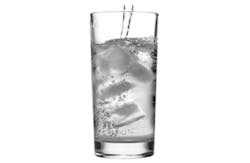A few decades back we saw an interesting consumer switch — a shift away from popular soft drinks and juices to interest in bottled water. Customers had money to spend and water offered a healthy alternative to other calorie-packed beverages for a public that was becoming more and more health conscious. Water is still the go-to beverage for many consumers who are health and hygiene focused. And, for these folks, stressing water’s health-related benefits and showcasing cleaning methods and antimicrobial technologies that are incorporated into today’s equipment are important messages.
Staying safe from cross contamination
Commercial facilities as well as homes have various commonly touched surfaces, known as “hot spots.” The buttons, levers and surfaces of a water cooler or point-of-use (POU) system, as examples, are considered hot spots and must be attended to accordingly. And, in addition to cleaning outer surfaces, a water treatment system’s interior surfaces must also be attended to.
Lou Busick, vice president of engineering at Oasis International, offers the following cleaning methods and products that are acceptable for keeping water cooler equipment clean inside and outside.
“The basic ‘mild dish detergent and warm water’ is probably still one of the most recommended cleaning methods as long as the system can be flushed thoroughly of all cleaning solution. It is critical to remove by physical abrasion any biofilm, mineral buildup and/or any other contamination on the surfaces in the system prior to sanitizing,” explains Busick. “Diluted bleach (sodium hypochlorite) can be safely used as a sanitizer, but careful attention must be given to concentration and exposure times as chlorine can be corrosive to metals. It is also very important to ensure all bleach is flushed out of the system before being put back into use.”
The cleaning frequency schedule will be determined on a number of factors, such as typical use, users, location in the facility or home, the system, the type of facility or home and so on. However, manufacturers do offer general best practices.
“We recommend that [our] ice and water dispensers be cleaned at least every six months,” says Mike Rice, who is the director of marketing for Follett Corporation. “More frequent cleaning and sanitizing may be required in high scale areas or in areas that have a higher presence of airborne organisms — for example, yeasts from baking.”
If unsure of a proper cleaning frequency schedule, water treatment dealers should consult with a professional cleaning distributor or manufacturer. And, always follow the manufacturer’s directions when cleaning any surface or hot spot.
Furthermore, the Centers for Disease Control and Prevention (CDC) recommends strict guidelines for proper hand-washing. The organization and many others believe that hand-washing is the number one defense against cross contamination. Consider spreading the word through signage around water cooler or drinking water stations to promote health and hygiene. For more information about CDC’s stance on proper hand-washing techniques, visit http://www.cdc.gov/handwashing/.
It’s what’s inside that counts
In ice and water machines, as mentioned, contamination can occur inside the system. Leading manufacturers are keen to this risk and have answered with bacteria fighting solutions to keep customers safe. These antimicrobial agents provide consistent protection.
“Throughout the years,” says Keith Pennison, strategic account manager at Pentair Filtration and Process, “the industry has been using silver impregnated carbon for inside water treatment. In the past several years, a lot of the manufacturers have actually been putting silver in the plastics of their equipment’s components.”
Rice’s company is one that uses this technology in its equipment. “[Our company] incorporates Agion antimicrobial treatment in critical ice and water contact components,” he adds. “While this silver-based antimicrobial does not treat the water or the ice, it inhibits the growth of microbes on the treated components.”
Water filtration technology has also improved in the areas of killing germs and bacteria. Advanced POU water cooler equipment, especially on municipally sourced water, provides extra disinfection in various forms.
“There are several technologies that are being used to minimize bacteria,” notes Busick. “Ozone is used to prevent the growth of biofilm on the inner surfaces. Ozone is an oxidizer that kills microorganisms as well. The challenge with ozone is preventing it from escaping to the surrounding area and exceeding the UL/EPA standard limits.”
According to Busick, the following are also considered effective technologies:
- Copper is a very powerful antimicrobial. Copper is a natural antimicrobial and some companies have registered their copper materials as an antimicrobial with the EPA.
- Ultraviolet is another way to treat the water surfaces within a reservoir. UV disrupts the DNA of the microorganisms so that they can’t reproduce. This does not treat the surfaces unless they are exposed to the UV light.
“It is not uncommon to incorporate two or more of these technologies into one product,” Busick says, adding that using hands free technologies is also an effective way to minimize cross contamination.
Have a plan and stick to it
Regardless of the water treatment technology selected, Pennison notes that an important step to always remember is ongoing cleaning needs of the unit. With any piece of water treatment equipment, he says, it is always important to plan a preventative maintenance schedule and stick to that schedule.
“And, best practices is always to wear gloves, replace O-rings, if applicable, and sanitize in well ventilated areas,” Pennison asserts.
Health focused building occupants and homeowners respond to clean, hygienic water coolers and other POU equipment. Perform these cleaning steps in front of the customers to show that safety and health is at the top of your list as well.
